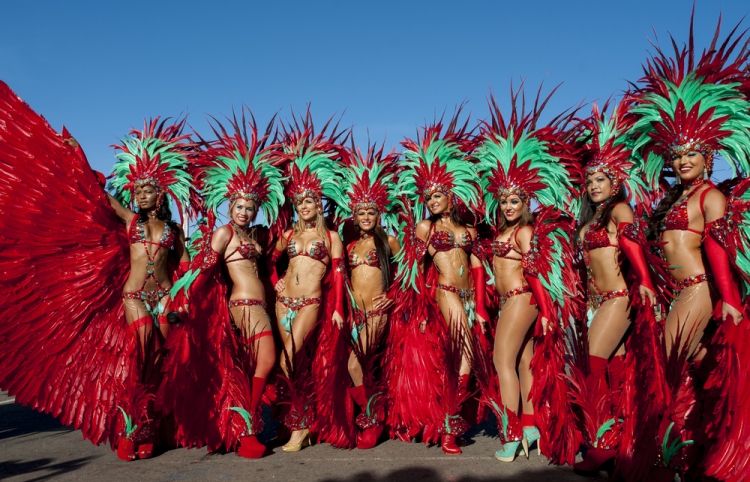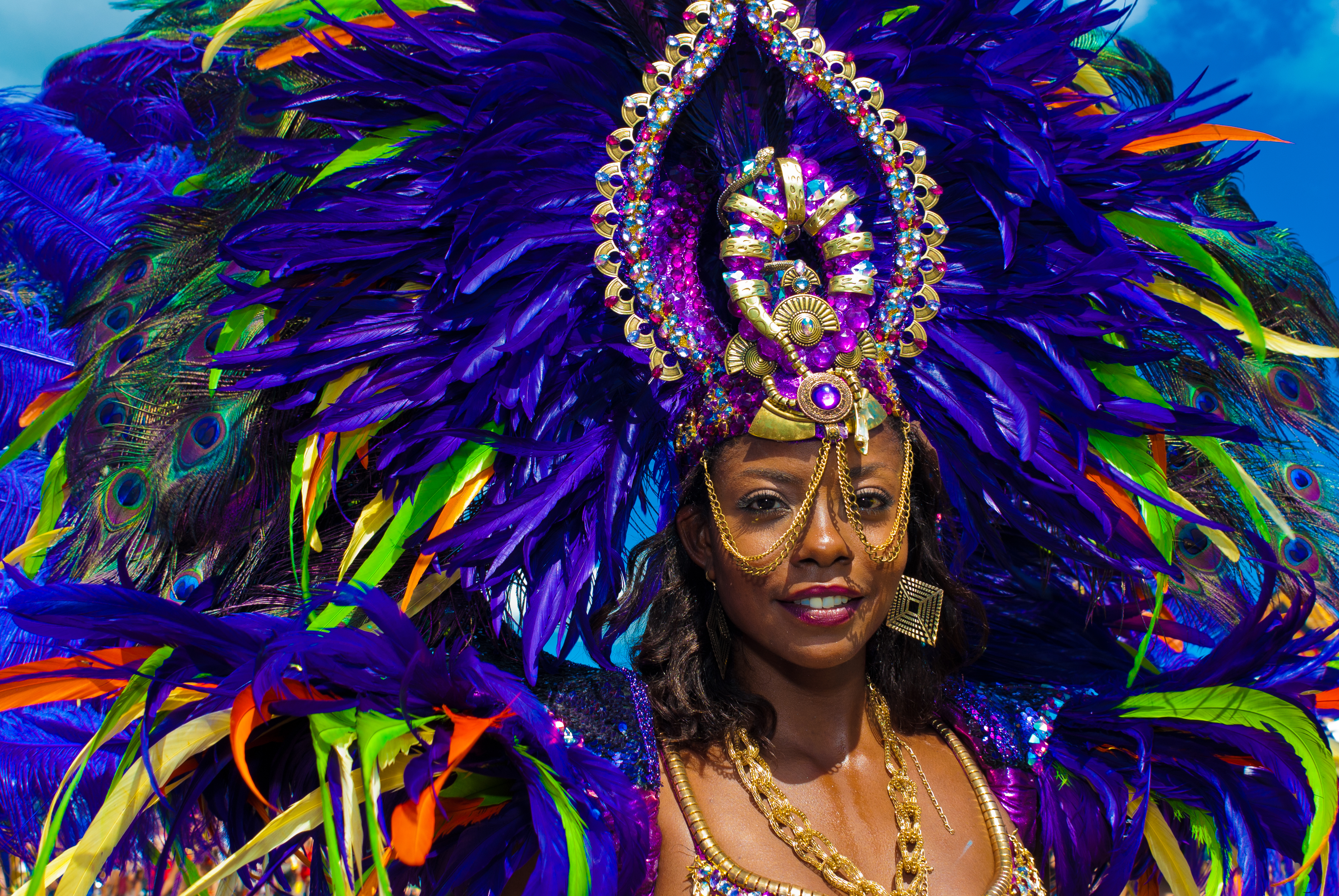Carnival in Trinidad and Tobago

I was born into what you would call a 'carnival family.' From the moment I could walk, my grandmother had no hesitation in signing me up for kiddies carnival. I can remember my first one like it was yesterday. I was five and my grandmother signed me up to be a yellow hibiscus flower. It was a nearly full bodied spandex suit, and it had a giant ring with massive petals around my neck. One look in the mirror and all I could think was, “what has this woman gotten me into?”
I hated the first few hours. It was the height of dry season, I was covered in glitter, and it felt like we had walked all over the city. My grandmother, however, never stopped dancing and smiling. I couldn't understand it. That is until we reached the Savannah where all bands for Kiddies carnival, Panorama, and carnival itself cross “The Stage.” I stood there hot and tired but suddenly it was time to cross. The sun was beating down, the Soca music was getting louder and louder, and all of these five-year-olds and their parents were preparing to go. Moko jumbies were moving on either sides of us, so high above that it looked like they could touch the clouds. Finally, the security cleared a path, and we all began to run up on stage. Holding my granny’s hand we ran up, jumped, danced, and sang all the way to the end of the stage. It was the first time I smiled all day. I finally felt the carnival spirit then: a euphoric feeling of complete freedom and fun.
The feeling of Carnival in Trinidad and Tobago is hard to describe. When the season officially begins in January, the entire island begins to live, breathe and immerse themselves in Carnival. From the buildup to the official two days (which fall on the Monday and Tuesday before Ash Wednesday), the experience encapsulates the essential elements of our culture, our history, and our existence as Trinbagonians.
These elements, traditions and the “spirit” of our carnival is deeply rooted in our history. Carnival in Trinidad emerged from French plantation owners who lived on the island around 1783. They brought their Catholic traditions with them and, despite British colonization a few years later, there were still many French plantation owners who remained on the island and continued their Catholic traditions with the British. Africans and people of mixed race were forbidden to participate, but as a result of the amount of festivities they had, there were moments that allowed the West African slaves to create their own celebrations such as Canboulay (the burning or harvesting of sugar cane).
Image Credit: Shutterstock.com / John de la Bastide
After Emancipation in 1838, Canboulay became an emblem of freedom. They began using masks, dancing, stick fighting, mocking the “whites” and reenacting scenes of their past enslavement. However, many of the whites saw this new carnival as immoral, and soon the British colonial government made several laws banning many of the activities around Carnival. It is through many of these restrictions that our traditions have come out of such as J'ouvert, Steel Pan and the traditional characters of Carnival.
J’ouvert (translated from French Patois) which means something like 'day break' or 'break of day, ' was a celebration reestablished after Canboulay was banned. J’ouvert, then and now was the official beginning of Carnival. J’ouvert today starts as early as 3 A.M on Monday morning and once you meet up with your J’ouvert band you immediately cover yourself in mud (YES, MUD). Sometimes paint, sometimes oil, but always Mud.
A typical day of J'ouvert goes like this. It's cold, it's early in the morning, and you are tired and covered in mud. There are massive trucks everywhere blasting Soca, and just when you think it is the absolute worst idea known to mankind, the sun starts to peek above the mountains and it begins shine over all these muddy bodies dancing, jumping and singing and you can feel the bass of the music shaking your entire body. You look around and can’t tell who is who but it feels like you are all one and for that short moment in time that comes around only once a year, its the closest thing to euphoria or as one article called it, raw magic.
A traditional character of Carnival is the Moko Jumbie. Moko Jumbies have always fascinated me, from that moment when I was five until now. I am constantly in awe of their height and the way they move in the air. According to Trinidad’s National Library, Moko Jumbie “was derived from the god "Moko", coming straight out of West African tradition. The term "jumbie" or ghost was added by the freed slaves. It was believed that the height of the stilts was associated with the ability to foresee evil faster than ordinary men. The Moko Jumbie was felt to be a protector of the village”
Much of our music has also stemmed from certain traditions. The music of Carnival has evolved over the years, from the drums our ancestors would beat to the making of the steel pan, music is an essential element of Carnival. Music during Carnival ranges from Afro-Trinidadian music like Calypso to Caribbean Indian music like Soca Chutney Soca, however the music you will hear the most during Carnival is Soca. Soca is a combination of African and East Indian music, it ranges from "Power Soca" which will have you up and jumping for those two days to "Groovy Soca" which will make you glide across those streets forgetting how much your feet hurt.
You can't mention Carnival music without talking about Steel Pan. Created in Trinidad during the period when the British Colonial government banned most traditions associated with Carnival, emancipated black slaves who lived in the hills of Laventille tried to find ways to practice their traditions of drumming and experimented with all sorts of materials from Bamboo to metal containers until they found and started using old oil drums. Thus, the steel pan was created and to this day it is a major part of the season with the national steel pan competition known as Panorama being one of the most important events of Carnival. Watching these bands perform is truly seeing passion in its purest form and there really is nothing quite as sweet as going to a Pan Yard with friends, drinking beers and watching them practice.
Monday and Tuesday
The official two days which end the season are the climax of the year. After cleaning off the mud from J’ouvert, you can sometimes get 2 hours of sleep, but that’s very rare! After that, its time to get ready for Monday! There is a certain energy you can feel on Monday morning; perhaps it's because you can hear your neighbours getting ready, or the sound of the judges on the TV describing costumes crossing the stage. Maybe it's the echo of Soca from the “music trucks” bouncing of the mountains in Port of Spain, but it feels exciting and you feel ready for whatever the day brings. On Monday, you don’t wear as elaborate a costume as Tuesday. However, similar to Tuesday, you head out into the streets meet up with your band and no soon after are you dancing, drinking and singing all across the city until sunset.
When the sun rises on Tuesday morning, it’s the official mark that it’s the last day of the season. You wear your entire costume with all of its elaborate pieces, cover yourself in glitter and head out once more. You might start off Tuesday morning feeling a little tired, but once that truck starts playing some “groovy soca” you start moving slowly with the beat and quickly forget how little sleep you’ve had. Quickly into that the music builds and that transitions to you jumping up with your friends, family and some strangers till the end of the day. As the sunsets on Tuesday the Carnival Tabanca sets in, your feet are hurting, you are most probably very drunk but your heart is full and the memories last well until next year!
Every year Carnival comes around it never disappoints, I still have that same wonderfully euphoric feeling I felt at five-years-old with my granny (who still plays Carnival every year even at 65). That feeling of freedom and fun that has been given to us by our ancestors through the season reminds us of where we have come from and who we are as people. The traditions, the music and the celebrations of Carnival bring together the past and the present in beautiful unison, and once a year we get to celebrate what it truly means to be from Trinidad and Tobago.


